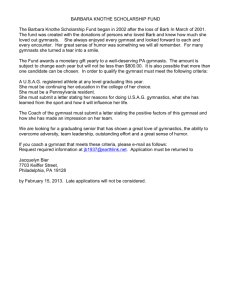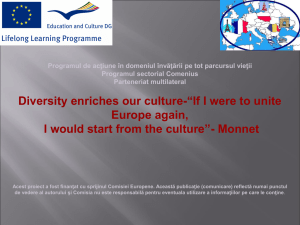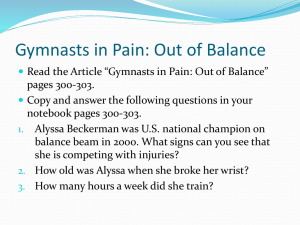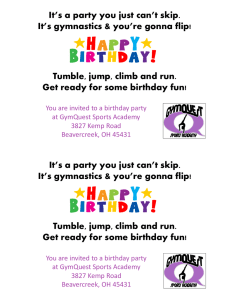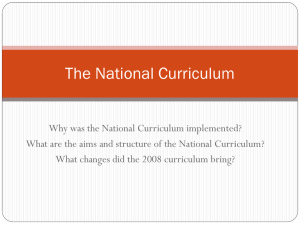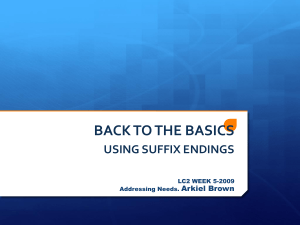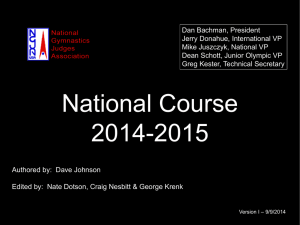PowerPoint
advertisement
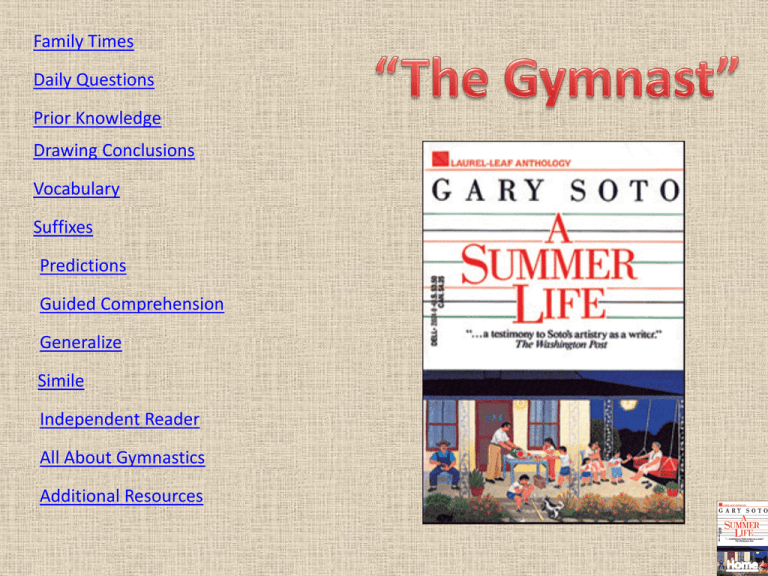
Family Times Daily Questions Prior Knowledge Drawing Conclusions Vocabulary Suffixes Predictions Guided Comprehension Generalize Simile Independent Reader All About Gymnastics Additional Resources Study Skills Genre: Autobiography Vocabulary Strategy: Word Structure Comprehension Skill: Draw Conclusion Comprehension Strategy: Visualize Question of the Week Why do people try to change themselves? Daily Questions: Why does Gary want to take up gymnastics? What do you think happens to Gary’s dream of being a gymnast? What kinds of skills and talents do you think are required to become a good gymnast? Activate Prior Knowledge Gymnastics K Gymnastics is a difficult sport. W What does it take to be a gymnast? It takes a lot of practice. Why would someone want to be a gymnast? L Draw Conclusions: A conclusion is a sensible decision you make after you think about facts or details that you read. Drawing conclusions may also be called making inferences. Use your prior knowledge to help you draw conclusions. What does the text say? What can I conclude? What do I already know? Visualize Active readers visualize as they read. They make pictures in their mind. Visualizing can help you understand what is happening in what you read. It can also help you draw conclusions about what is happening and why. Write: 1.Read “How to Do a Cartwheel.” Use a graphic organizer like the one above to draw a conclusion about which way to start a cartwheel. 2.Describe how to do a handstand, a somersault, or some other action without naming it. Exchange papers with a classmate. Try to visualize and draw a conclusion about what your classmate is describing. Word Rating Chart Word Bluish Cartwheels Gymnastics Hesitation Limelight Skidded Somersault Throbbing Wincing Know Have Seen Don’t Know Compound Words: Two words this week are compound words. Which two words are they? Limelight Cartwheels What two smaller words make up each compound word. Lime and light Cart and wheel Look for compound words as you read “The Gymnast” Bluish Somewhat blue Cartwheels Sideways handsprings with the legs and arms kept straight. Gymnastics A sport in which very difficult exercises are performed. Hesitation Act of failing to act promptly Limelight Center of public attention and interest Skidded Slipped or slid sideways while moving. Somersault To run or jump, turning the heels over the head Throbbing Beating rapidly or strongly Wincing Drawing back suddenly. More Words to Know: Backflips: backwards somersaults performed in the air. Solitary: without companions Spindly: Very long and slender Practice Lesson Vocabulary: True or False Gymnastics is easy to learn. Cartwheels don’t involve using your hands. Someone would be wincing in pain if he had fallen off his bike. Fill in the blank. As he walked in the slippers, Gary’s feet were _______________. Gary’s ankles turned ________________ in color. Gary’s first _____________made him feel a little dizzy. Issac loved the ______________________, so he looked around for an audience. Gary was nervous, but he finally tried a back flip after much _________________. Vocabulary Strategy: Suffixes: -ion, -ish, -tion A suffix is a syllable added to the end of a base word that changes the base word’s meaning. The spelling of the base word may also change when the suffix is added. For example, when the suffix –ion is added to appreciate, the final e is dropped: appreciation. Adding this suffix adds the meaning “the act or state of being ____.” The suffix –ish adds the meaning “somewhat” or “like,” as in brownish. Recognizing a suffix can help you figure out the meaning of an unknown word. 1. Look at the unknown word. See if you recognize a base word in it. 2. Check to see if the suffix –ion, -tion, or –ish has been added to the base word. 3. Ask yourself how the suffix changes the meaning of the base word. 4. Try the new meaning in the sentence to see if it makes sense. As you read “It’s Easier in Daydreams,” look for words that end with suffixes. Analyze the base words and the suffixes to figure out the meanings of words you do not know. Genre: Autobiography An autobiography is the story of a person’s life or of a single event in ti, told by the person who lived it. As you read, notice how the author looks back at himself from a humorous point of view. Will Gary succeed in becoming the person he wants to be? Preview and Predict Read the opening question and the title on pp. 488-489. Do a picture walk through the selection. When you finish, identify the subject of the selection. “What do you think the ‘The Gymnast’ is about?” Use your lesson vocabulary in your discussion. Guided Comprehension: Reread p. 490, paragraph 1. What makes Gary feel jealous? From whose point of view is “The Gymnast” told? How do you know? Make a generalization about gymnasts based on what you read about Issac. What does Gary seem to think is most interesting about gymnastics? Does Gary remind you of anyone in your own life? Explain why. How do you think the selection will end? What helped you make your prediction? What is the base word in hesitation? What suffix has been added to the base word? What does the word mean? What details on p. 497 help you visualize the scene? What is the author trying to tell you when he says, “ I ate a plum and pictured my cousin, who was probably cartwheeling to the audience of one sleeping dog”? Does the autobiography remind you of any other nonfiction selections you’ve read? Think about events, characters, and the point of view from which it’s told. Generalize: Generalizations are broad statements or rules that apply to many examples. Model: In this story, Issac practices a lot. I know that gymnastics is very hard. I can generalize that gymnasts spend a lot of time practicing. Reread the second paragraph on p. 493. What generalization does Issac make about gymnasts? Simile A simile is a comparison of two unlike things that are alike in at least one way. In a simile, words of comparison such as like or as are used. Simile is a kind of figurative language. On p.494, paragraph 1, “….admiring my feet, which looked like bloated water balloons” is a simile. Write the simile in your notebook, as well as an explanation of the two things being compared. Find another simile in “The Gymnast” on p. 493, paragraph 3. Write the simile and answer these questions. 1. What comparison word is used in the simile? 2. What two things are being compared? 3. What other items could have been used to compare the two things? SUMMARY This book discusses strange sports that use unusual gear. It describes the sports of curling, rhythmic gymnastics, and jai alai. COMPREHENSION QUESTIONS PAGE 11 What conclusions can you draw about why changes in curling were made? PAGE 12 What are the two main parts of rhythmic gymnastics? PAGE 23 What gear do jai alai players wear? PAGE 20 What effect would playing jai alai with no equipment have on its players? SUMMARY This book describes the history of the Olympic Games and how the games have changed through the years. It focuses on the historic 1904 Olympics and its memorable athletes like Felix Carvajal. COMPREHENSION QUESTIONS PAGES 11 AND 13 What conclusions can you draw about Felix Carvajal? PAGES 14 AND 15 What made the 1904 marathon difficult? PAGE 18 Why was it amazing that Ray Ewry competed in the Olympics? PAGE 19 Based on the chart, in which events did George Eyser win the gold medal? SUMMARY This book discusses what it takes to be a great athlete. It tells about the demands of training and competing that athletes have to endure to prepare for a major competition. It also highlights various notable athletes, such as Jim Thorpe and Babe Didrikson Zaharias. COMPREHENSION QUESTIONS PAGE 6 About how many years ago did the first Olympic games occur? PAGE 8 What conclusion can you draw about what the Ancient Greeks thought about athletes? PAGE 8 What details helped you come to your conclusion in the question above? PAGE 13 How many miles would Jim Thorpe run to get home from school? PAGE 15 What made Babe Didrikson Zaharias such a good athlete? Genre: Online Reference Sources You can find reference sources, such as almanacs and dictionaries, on Internet Web sites. Some Web sites give you several different reference sources all in one place. Text Features: These electronic references sources look a lot like printed sources, and they’re organized the same way. Instead of turning pages by hand, you click through them with a mouse. How does Alice get from the search result screen to the encyclopedia entry for gymnastics? How are the dictionary entries on pp. 502-503 like an entry in a printed dictionary? Picture steps Alice takes as she does her search. A definition and picture help you understand the term. Look back at “The Gymnast” to see what kinds of moves the your Gary Soto was practicing. Compare them with the information here. Which event do you think Gary was practicing for, and why do you think so? Describe your thinking and illustrate it with drawings. Additional Resources http://www.garysoto.com/
